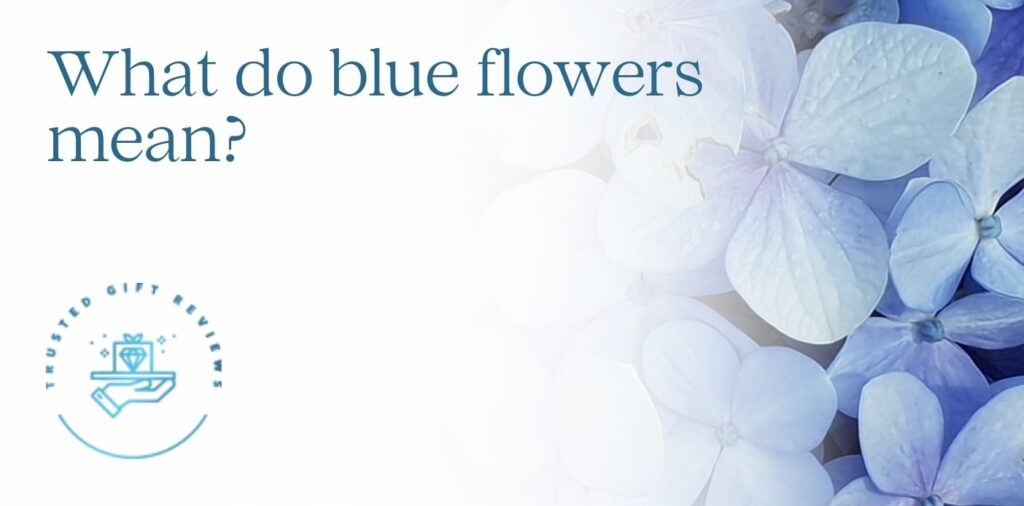Blue flowers have plenty of meanings such as calmness and serenity, trust and commitment, hope for the future, dreams, and even mystery.
The particular shade of blue also alters their meaning. For instance, baby blue blooms mean delicate beauty, royal blue represents energy and confidence, and dark blue flowers indicate heartbreak or sadness.
Learn more about blue flowers by reading this detailed guide. Here, we’ll discuss some popular blue flowers, their meanings, and their cultural impact, among other interesting things.
About Blue Flowers


No. of species: At least 20
Native habitat: Midlatitude regions
USDA growing zones: 4 to 8
Existing on the planet are more than 20 species of blue flowers. Compared to other colors of flowers, they are rare but charming nonetheless.
Some blue flowers grow naturally in the wild at moderate temperatures, and some are hybrids bred from different plants by expert botanists.
The color of flowers is produced by their pigments. These flower pigments consist of three chemicals, namely anthocyanins, betalains, and carotenoids.
Now each flower variety has different amounts of these compounds, resulting in its specific color that can range from white to burgundy to royal blue like that of the elegant irises.
7 Popular Blue Flowers


Blue flowers are often hard to find, but there are ones you can get from your local florists.
1. Iris


Iris is a spring-flowering plant with supreme beauty. It’s characterized by its sword or crown-like shape with hanging sides.
The flower gets its name from the Greek goddess of the rainbow, Iris.
This species’ colors range from baby blue to semi-black. Also, the iris has wonderful meanings of faith, hope, trust, and courage.
2. Hydrangea


With flowers clustered in a lovely ball form, blue hydrangeas are another undisputed favorite of growers and gardeners.
Hydrangea also stems from the Greek words hydor, meaning water, and angeion, meaning vessel, referring to the plant’s seed pods that are shaped like a water container.
Breathtaking and stylish, these flowers are commonly used in anniversaries, engagements, and weddings.
Interestingly, they have negative meanings too—regret, apology, and forgiveness. They also meant difficulty in finding a suitor in Victorian England.
3. Bluebell


Bluebells are known for their bell-shaped blossoms. The Spanish bluebell (pictured above) and the English bluebell are popular as garden ornamentals.
Their connotations are humility, gratitude, and constancy owing to the naturally drooping flowers and persistence in numbers.
In addition to that, they emit a sweet and pleasant aroma that makes them a gem in one’s garden or for gifting someone you care about.
4. Morning Glory


Aptly named, the blue morning glory is an awe-inspiring flower with its full fan-like flowers, romantic, graceful tendrils, and unique, glowing yellow center.
It’s a vining flower that can magnificently grace your garden and front yard. By the way, it’s also the birth flower of September babies.
Plus, the flower is easy to maintain and becomes heat and drought-tolerant once established. That lends the meaning of resilience and strength to this sun-loving flower.
5. Delphinium


Native to the Northern Hemisphere, blue delphiniums have vibrant, spiky flowers borne on towering green stems. They’re the most common color of delphiniums.
They are named after the Greek word delphī́nion, which is a variation of delphī́s, meaning dolphin. The flower’s spur, its protruding part, looks like a dolphin’s tail.
Blue delphiniums represent dignity, encouragement, and joy. They also mean remembering someone dear.
6. Sweet Pea


Another beloved flower for gardens and trellises is the blue sweet pea. They have small butterfly-like flowers and long, trailing stems.
Blue sweet peas represent bliss, kindness, friendship, and good wishes. On the flip side, its cluster of flowers also signals goodbye to someone.
The trick to having fantastic, healthy sweet peas is to plant them early in late winter or early spring. They are pretty tough plants and thrive in USDA hardiness winter zones 7 or below.
7. Poppy


The pretty blue poppy has ruffly concave petals and a dark green stem. It’s native to Europe, Japan, and the Arctic.
While red poppies suggest remembrance, sympathy, and death and are worn by people in the West to commemorate World War I soldiers, blue poppies symbolize wealth and fortune in the East.
Hence, you can gift blue poppies to a person who’s celebrating a milestone, anniversary, shop opening, or the New Year.
Blue Flowers and Their Meaning and Symbolism


When floriography became highly popular in England during the 19th century, blue flowers had a slew of meanings.
Among them are love, affection, hope, trust, commitment, and inspiration. Besides that, they expressed serenity, calmness, and sympathy.
And like deep blue waters, blue blossoms also symbolized mystery or the unknown.
However, blue flowers have some bad meanings as well. These are solitude, unfriendliness, coldness, apology, and regret.
Blue Flowers and Their Spiritual Meaning
Blue flowers are an important symbol or motif in different religions and beliefs.
- Christianity
For Catholics, they stand for the Virgin Mary and the sorrow of childbirth. Moreover, they’re associated with the Holy Spirit, which Catholics believe helps them know God and his will.
- Judasim
For Judaism believers, blue blossoms stand for sincerity and commitment between two people. The blue rose, in particular, represents the impossible.
- Hinduism
All Hindu gods are portrayed in blue, signifying their power and divinity. Additionally, it stands for happiness, love, and peace in the said faith.
- Buddhism
The blue flower is equally important in the Buddhist religion. A partly opened blue lotus stands for the person evolving spiritually and rising over their desires.
For Buddhists, blue flowers symbolize the perfection of wisdom and knowledge, which they believe allows one to live and coexist with others in stillness.
Blue Flowers and Their Cultural Significance


For many centuries, blue flowers have played an important role in the culture of different countries. Let’s take a look at some of them here:
In Ancient Egypt
The blue water lily or lotus was considered sacred in Ancient Egypt. They believed it connected the people to the divine and brought their minds to a higher consciousness or state of mind.
For this reason, the star-shaped flowers were placed on altars, arches, and temples as offering to their gods.
What’s more, the blue lotus, with its delightful and pleasing scent, was also used to make sacred wines for religious events, ceremonies, and rituals.
In Ancient Greece
In Greek myth, the blue iris represents the Greek goddess of the rainbow, Iris. She’s responsible for making rainbows in the sky, which is most often seen by coastal dwellers.
Delphiniums also appeared in Greek myth as the favorite flower of Apollo, the Olympian deity of the sun, archery, poetry, music, and dance.
Greek hunters tipped their arrows with wolfsbane or monkshood, a bluish purple flower, to stop wolves from killing and eating their flocks.
In Ancient Rome
An important blue flower in Rome is the borage or staflower. It was used to cure sad or depressed individuals.
As such, Roman author and soldier Pliny the Elder named the plant Euphrosinum or merriment in English.
Blue Flowers in Art and Literature


Art and literature have also been a mode of expression for magnificent blue flowers. Here are several notable examples of it:
Legendary Dutch painter Vincent Van Gogh remarkably painted blue flowers in Still Life with Irises in 1890.
English Writer C.S. Lewis, who famously penned The Chronicles of Narnia among other fiction and Christian books, used blue flowers to express his longing for something beautiful in his autobiography.
In one novel by Novalis, the fictional hero Heinrich von Ofterdingen dreams of the blue flower and compared it to his long-distance love for a woman.
Plus, Tennessee Williams wrote of blue flowers as a metaphor for fragility in his play The Glass Menagerie. And well-known American poet Robert Forst featured the blue flower in several of his works.
FAQS about Blue Flowers
- What is the rarest blue flower?
Most people consider the grape hyacinth as the rarest blue flower. This spring perennial features an extravagant round cluster of blooms; long, straight leaves; and bulb roots.
- Do blue roses exist?
Unfortunately, blue roses don’t exist in nature at this time. Scientists attempted to create them through genetic engineering and selective breeding but failed.
But the good news is that artificial dyeing can artificially create mesmerizing blue roses, which make a special gift to someone. Some select florists provide this service to their clients.
- What is a popular blue flower tattoo design?
Blue bellflowers have been a great chosen tattoo for many people. And the meaning of the blue bellflowers is really beautiful: gratitude, constancy, and eternal love.




